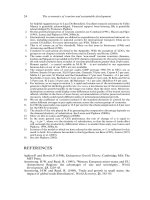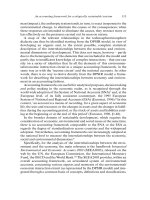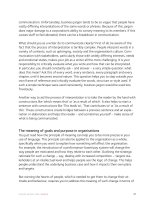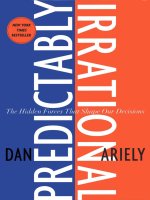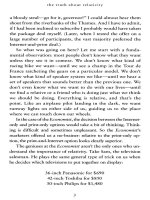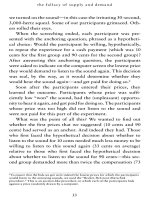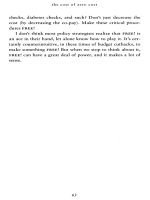predictably irrational the hidden forces that shape our decisions phần 5 pps
Bạn đang xem bản rút gọn của tài liệu. Xem và tải ngay bản đầy đủ của tài liệu tại đây (346.16 KB, 30 trang )
the
influence of
arousal
straight A's throughout high school, where he was captain of
the varsity volleyball team. He sympathized with libertarians
and tended to vote Republican. Friendly and amiable, he had
a
steady girlfriend who he'd been dating for a year. He planned
to go to medical school and had a weakness for spicy
California-roll
sushi and for the salads at Cafe Intermezzo.
Roy
met with our student research assistant,
Mike,
at
Strada
coffee
shop—Berkeley's patio-style percolator for
many an intellectual thought, including the idea for the solu-
tion to Fermat's last theorem. Mike was slender and tall,
with short hair, an artistic air, and an engaging smile.
Mike
shook
hands
with Roy, and they sat down. "Thanks
for
answering our ad, Roy," Mike said, pulling out a few
sheets of paper and placing them on the table. "First, let's go
over
the consent forms."
Mike
intoned the ritual decree: The study was about deci-
sion making and sexual arousal. Participation was voluntary.
Data
would be confidential. Participants had the right to
contact
the committee in charge of protecting the rights of
those participating in experiments, and so on.
Roy
nodded and nodded. You couldn't find a more agree-
able
participant.
"You
can stop the experiment at any time," Mike con-
cluded. "Everything understood?"
"Yes,"
Roy said. He grabbed a pen and signed. Mike
shook
his hand.
"Great!"
Mike took a cloth bag out of his knapsack.
"Here's what's going to happen." He
unwrapped
an Apple
iBook
computer and opened it up. In addition to the stan-
dard
keyboard, Roy saw a
12-key
multicolored keypad.
"It's
a specially equipped computer," Mike explained.
"Please
use only this keypad to respond." He touched the
93
predictably
irrational
keys
on the colored pad. "We'll give you a code to enter, and
this code will let you start the experiment. During the ses-
sion,
you'll be asked a series of questions to which you can
answer on a scale ranging between 'no' and 'yes.' If you think
you would like the activity described in the question, answer
'yes,'
and if you think you would not, answer 'no.' Remem-
ber
that you're being asked to predict how you would behave
and what kind of activities you would like when aroused."
Roy
nodded.
"We'll
ask you to sit in your bed, and set the computer up
on a chair on the left side of your bed, in clear sight and reach
of
your bed," Mike went on. "Place the keypad next to you so
that you can use it without any difficulty, and be sure you're
alone."
Roy's
eyes twinkled a little.
"When you finish with the session, e-mail me and we will
meet again, and you'll get your ten bucks."
Mike
didn't
tell Roy about the questions themselves. The
session
started by asking Roy to imagine that he was sexually
aroused, and to answer all the questions as he would if he
were aroused. One set of questions asked about about sexual
preferences.
Would he, for example, find women's shoes
erotic?
Could he imagine being attracted to a 50-year-old
woman? Could it be fun to have sex with someone who was
extremely
fat? Could having sex with someone he hated be
enjoyable?
Would it be fun to get tied up or to tie someone
else
up? Could "just kissing" be frustrating?
A
second set of questions asked about the likelihood of
engaging in immoral behaviors such as date rape. Would Roy
tell
a woman that he loved her to increase the chance that she
would have sex with him? Would he encourage a date to
drink to increase the chance that she would have sex with
94
the
influence of arousal
him?
Would he keep trying to have sex after a date had said
"no"?
A
third set of questions asked about Roy's likelihood of
engaging in behaviors related to unsafe sex. Does a condom
decrease sexual pleasure? Would he always use a condom if
he
didn't
know the sexual history of a new sexual partner?
Would he use a condom even if he was afraid that a woman
might change her mind while he went to get
it?*
A
few days later, having answered the questions in his
"cold,"
rational state, Roy met again with Mike.
"Those
were some interesting questions," Roy noted.
"Yes,
I know," Mike said coolly. "Kinsey had nothing on
us. By the way, we have another set of experimental sessions.
Would you be interested in participating again?"
Roy
smiled a little, shrugged, and nodded.
Mike
shoved a few pages toward him. "This time we're
asking you to sign the same consent form, but the next task
will
be slightly different. The next session will be very much
the same as the last one, but this time we want you to get
yourself
into an excited state by viewing a set of arousing
pictures and masturbating. What we want you to do is arouse
yourself
to a high level, but not to ejaculate. In case you do,
though, the computer will be protected."
Mike
pulled out the Apple
iBook.
This time the keyboard
and the screen were covered with a thin layer of Saran wrap.
Roy
made a
face.
"I
didn't
know computers could get
pregnant."
"Not a chance," Mike laughed. "This one had its tubes
tied. But we like to keep them clean."
Mike
explained that Roy would browse through a series
*For
a complete lists of the questions we asked, see the appendix to this
chapter.
95
predictably
irrational
of
erotic pictures on the computer to help him get to the right
level
of arousal; then he would answer the same questions as
before.
WITHIN
THREE
MONTHS, some fine
Berkeley
undergraduate
students had undergone a variety of sessions in different or-
ders. In the set of sessions conducted when they were in a
cold,
dispassionate state, they predicted what their sexual
and moral decisions would be if they were aroused. In the set
of
sessions conducted when they were in a hot, aroused state,
they also predicted their decisions—but this time, since they
were actually in the grip of passion, they were presumably
more aware of their preferences in that state. When the study
was completed, the conclusions were consistent and clear—
overwhelmingly
clear, frighteningly clear.
In
every
case,
our bright young participants answered the
questions very differently when they were aroused from when
they were in a "cold" state. Across the 19 questions about
sexual
preferences, when Roy and all the other participants
were aroused they predicted that their desire to engage in a
variety
of somewhat odd sexual activities would be nearly
twice
as high as (72 percent higher than) they had predicted
when they were cold. For example, the idea of enjoying con-
tact
with animals was more than twice as appealing when
they were in a state of arousal as when they were in a cold
state.
In the five questions about their propensity to engage in
immoral
activities, when they were aroused they predicted
their
propensity to be more than twice as high as (136 per-
cent
higher than) they had predicted in the cold state.
Simi-
larly,
in the set of questions about using condoms, and despite
the warnings that had been hammered into them over the
96
the
influence of
arousal
years about the importance of condoms, they were 25 per-
cent
more likely in the aroused state than in the cold state to
predict that they would forego condoms. In all these cases
they failed to predict the influence of arousal on their sexual
preferences,
morality, and approach to safe sex.
The
results showed that when Roy and the other partici-
pants were in a cold, rational, superego-driven state, they re-
spected women; they were not particularly attracted to the
odd sexual activities we asked them about; they always took
the moral high ground; and they expected that they would
always use a condom. They thought that they understood
themselves,
their preferences, and what actions they were
capable
of. But as it turned out, they completely underesti-
mated their reactions.
No matter how we looked at the numbers, it was clear
that the magnitude of underprediction by the participants
was substantial. Across the board, they revealed in their un-
aroused state that they themselves did not know what they
were like once aroused. Prevention, protection, conservatism,
and morality disappeared completely from the radar screen.
They
were simply unable to predict the degree to which pas-
sion would change them.*
IMAGINE
WAKING
UP one morning, looking in the mirror,
and discovering that someone else—something alien but
human—has taken over your body. You're uglier, shorter,
hairier; your lips are thinner, your incisors are longer, your
nails are fîlthy, your
face
is flatter. Two cold, reptilian eyes
These
results apply most directly to sexual
arousal
and its influence on who we are; but
we can also assume
that
other
emotional states
(anger,
hunger, excitement, jealousy, and
so on) work in similar ways, making us
strangers
to ourselves.
97
predictably
irrational
gaze back at you. You long to smash something,
rape
some-
one.
You are not you. You are a monster.
Beset
by this nightmarish vision, Robert Louis Stevenson
screamed
in his sleep in the early
hours
of an
autumn
morn-
ing in
1885.
Immediately after his wife awoke him, he set to
work on what he called a "fine bogey tale"—Dr.
Jekyll
and
Mr.
Hyde—in
which he said, "Man is not truly one, but truly
two." The book was an overnight success, and no wonder.
The
story captivated the imagination of
Victorians,
who were
fascinated
with the dichotomy between repressive propriety—
represented by the mild-mannered scientist Dr. Jekyll—and
uncontrollable passion, embodied in the
murderous
Mr.
Hyde. Dr.
Jekyll
thought he understood how to control him-
self.
But when Mr. Hyde took over, look out.
The
story was frightening and imaginative, but it wasn't
new. Long before
Sophocles's
Oedipus
Rex and Shakespeare's
Macbeth,
the war between interior good and evil had been
the
stuff
of myth, religion, and literature. In Freudian terms,
each
of us houses a
dark
self,
an id, a brute that can
unpre-
dictably
wrest control away from the superego. Thus a pleas-
ant, friendly neighbor, seized by road rage, crashes his car
into a semi. A teenager grabs a gun and shoots his friends. A
priest rapes a boy. All these otherwise good people assume
that they
understand
themselves. But in the heat of passion,
suddenly, with the flip of some interior switch, everything
changes.
Our experiment at
Berkeley
revealed not just the old story
that we are all like
Jekyll
and Hyde, but also something
new—that every one of us, regardless of how "good" we are,
underpredicts the
effect
of passion on our behavior. In every
case,
the participants in our experiment got it wrong. Even
the most brilliant and rational person, in the heat of passion,
98
the
influence of
arousal
seems
to be absolutely and completely divorced from the per-
son he thought he was. Moreover, it is not just that people
make wrong predictions about themselves—their predictions
are wrong by a large margin.
Most
of the time, according to the results of the study, Roy
is
smart, decent, reasonable, kind, and trustworthy. His frontal
lobes
are fully functioning, and he is in control of his behavior.
But
when he's in a state of sexual arousal and the reptilian
brain takes over, he becomes unrecognizable to himself.
Roy
thinks he knows how he will behave in an aroused
state,
but his understanding is limited. He doesn't truly un-
derstand that as his sexual motivation becomes more intense,
he may throw caution to the wind. He may risk sexually
transmitted diseases and unwanted pregnancies in order to
achieve
sexual gratification. When he is gripped by passion,
his emotions may blur the boundary between what is right
and what is wrong. In
fact,
he doesn't have a clue to how con-
sistently
wild he really is, for when he is in one state and tries
to predict his behavior in another state, he gets it wrong.
Moreover,
the study suggested that our inability to
under-
stand ourselves in a different emotional state does not seem
to improve with experience; we get it wrong even if we spend
as much time in this state as our
Berkeley
students spend
sexually
aroused.
Sexual
arousal is familiar, personal, very
human, and utterly commonplace. Even so, we all systemati-
cally
underpredict the degree to which arousal completely
negates our superego, and the way emotions can take control
of
our behavior.
WHAT
HAPPENS,
THEN,
when our irrational
self
comes alive
in an emotional place that we think is familiar but in
fact
is
99
predictably
irrational
unfamiliar? If we
fail
to really understand ourselves, is it
possible
to somehow predict how we or others will behave
when "out of our heads"—when we're really angry, hungry,
frightened, or sexually aroused? Is it possible to do some-
thing about this?
The
answers to these questions are profound, for they in-
dicate that we must be wary of situations in which our Mr.
Hyde may take over. When the boss criticizes us publicly, we
might be tempted to respond with a vehement e-mail. But
wouldn't we be better off
putting
our reply in the "draft"
folder
for a few days? When we are smitten by a sports car
after
a test-drive with the wind in our hair, shouldn't we take
a
break—and discuss our spouse's plan to buy a minivan—
before
signing a contract to buy the car?
Here are a few more examples of ways to protect ourselves
from ourselves:
Safe
Sex
Many
parents and teenagers, while in a cold, rational, Dr.
Jekyll
state, tend to believe that the mere promise of
abstinence—commonly
known as "Just say no"—is sufficient
protection against sexually transmitted diseases and un-
wanted pregnancies. Assuming that this levelheaded thought
will
prevail even when emotions reach the boiling point, the
advocates of "just saying no" see no reason to carry a con-
dom with them. But as our study shows, in the heat of pas-
sion,
we are all in danger of switching from "Just say no" to
"Yes!"
in a heartbeat; and if no condom is available, we are
likely
to say yes, regardless of the dangers.
What
does this suggest? First, widespread availability of
condoms is essential. We should not decide in a
cool
state
100
the influence of arousal
whether or not to bring condoms; they must be there just in
case.
Second, unless we understand how we might react in an
emotional state, we will not be able to predict this transfor-
mation. For teenagers, this problem is most likely exacer-
bated, and
thus
sex education should focus less on the
physiology and biology of the reproductive system, and more
on strategies to deal with the emotions that accompany
sex-
ual arousal. Third, we must admit that carrying condoms
and even vaguely understanding the emotional firestorm of
sexual
arousal may not be enough.
There
are most likely many situations where teenagers
simply won't be able to cope with their emotions. A better
strategy, for those who want to guarantee that teenagers
avoid sex, is to teach teenagers that they must walk away
from the fire of passion before they are
close
enough to be
drawn
in. Accepting this advice might not be easy, but our
results suggest that it is easier for them to fight temptation
before
it arises than after it has started to lure them in. In
other words, avoiding temptation altogether is easier than
overcoming it.
To
be sure, this sounds a lot like the "Just say no" cam-
paign, which urges teenagers to walk away from sex when
tempted. But the difference is that "Just say no" assumes we
can
turn
off passion at will, at any point, whereas our study
shows this assumption to be
false.
If we put aside the debate
on the pros and cons of teenage sex, what is clear is that if we
want to help teenagers avoid sex, sexually transmitted dis-
eases,
and unwanted pregnancies, we have two strategies.
Either
we can teach them how to say no
before
any tempta-
tion takes hold, and before a situation becomes impossible to
resist;
or alternatively, we can get them prepared to deal with
the consequences of saying yes in the heat of passion (by
101
predictably
irrational
carrying a condom, for example). One thing is sure: if we
don't teach our young people how to deal with sex when they
are
half
out of their minds, we are not only fooling them;
we're fooling ourselves as well. Whatever lessons we teach
them, we need to help them understand that they will react
differently
when they are calm and
cool
from when their hor-
mones are raging at fever pitch (and of course the same also
applies to our own behavior).
Safe Driving
Similarly,
we need to teach teenagers (and everyone
else)
not
to drive when their emotions are at a
boil.
It's not just inexpe-
rience
and hormones that make so many teenagers crash their
own or their parents' cars. It's also the car full of laughing
friends, with the CD player blaring at an adrenaline-pumping
decibel
level, and the driver's right hand searching for the
french
fries or his girlfriend's knee. Who's thinking about risk
in that situation? Probably no one. A recent study found that
a
teenager driving alone was 40 percent more likely to get into
an accident than an
adult.
But with one other teenager in the
car,
the percentage was twice that—and with a third teenager
along for the ride, the percentage doubled again.
5
To
react to this, we need an intervention that does not rely
on the premise that teenagers will remember how they wanted
to behave while in a cold state (or how their parents wanted
them to behave) and follow these guidelines even when they
are in a hot state. Why not build into cars precautionary de-
vices
to
foil
teenagers' behavior? Such cars might be equipped
with a modified OnStar system that the teenager and the par-
ents configure in a cold state. If a car exceeds 65 miles per
hour on the highway, or more than 40 miles per hour in a
102
the
influence of
arousal
residential zone, for example, there will be consequences. If
the car exceeds the speed limit or begins to make erratic
turns, the radio might switch from
2Pac
to Schumann's
Sec-
ond Symphony (this would slow most teenagers). Or the car
might blast the air conditioning in winter, switch on the heat
in summer, or automatically
call
Mom (a real downer if the
driver's friends are present). With these substantial and im-
mediate consequences in mind, then, the driver and his or her
friends would realize that it's time for Mr. Hyde to move over
and let Dr.
Jekyll
drive.
This
is not at all far-fetched. Modern cars are already full
of
computers that control the fuel injection, the climate sys-
tem, and the sound system. Cars equipped with OnStar are
already linked to a wireless network. With today's technol-
ogy,
it would be a simple matter for a car to automatically
call
Mom.
Better Life Decisions
Not uncommonly, women who are pregnant for the first time
tell
their doctors, before the onset of labor, that they will re-
fuse
any kind of painkiller. The decision made in their cold
state is admirable, but they make this decision when they
can't
imagine the pain that can come with childbirth (let
alone the challenges of child rearing). After all is said and
done, they may wish they'd gone for the epidural.
With
this in mind, Sumi (my lovely
wife)
and I, readying
ourselves for the birth of our first child, Amit, decided to
test our mettle before making any decisions about using an
epidural. To do this, Sumi plunged her
hands
into a bucket
of
ice for two minutes (we did this on the advice of our
birth coach, who swore to us that the resulting pain would
103
predictably
irrational
be
similar to the pain of childbirth), while I coached her
breathing. If Sumi was unable to bear the pain of this expe-
rience,
we figured, she'd probably want painkillers when
she was going through the actual birth. After two minutes
of
holding her
hands
in the ice bucket, Sumi clearly
under-
stood the appeal of an epidural. During the birth itself, any
ounce of love Sumi ever had for her husband was completely
transferred to the anesthesiologist, who produced the epi-
dural
at the critical point. (With our second child, we made
it
to the hospital about two minutes before Neta was born,
so
Sumi did end up experiencing an analgesic-free birth
after
all.)
LOOKING
FROM
ONE emotional state to another is difficult.
It's
not always possible; and as Sumi learned it can be pain-
ful.
But to make informed decisions we need to somehow
experience
and understand the emotional state we will be in
at the other side of the experience. Learning how to bridge
this gap is essential to making some of the important deci-
sions
of our lives.
It
is unlikely that we would move to a different city with-
out asking friends who live there how they like it, or even
choose
to see a film without reading some reviews. Isn't it
strange that we invest so little in learning about both sides of
ourselves?
Why should we reserve this subject for psychology
classes
when failure to understand it can bring about re-
peated failures in so many aspects of our lives? We need to
explore
the two sides of ourselves; we need to understand the
cold
state and the hot state; we need to see how the gap be-
tween the hot and cold states benefits our lives, and where it
leads us astray.
104
the
influence of
arousal
What
did our experiments suggest? It may be that our
models of human behavior need to be rethought. Perhaps
there is no such thing as a fully integrated human being. We
may,
in
fact,
be an agglomeration of multiple selves. Al-
though there is nothing much we can do to get our Dr.
Jekyll
to fully appreciate the strength of our Mr. Hyde, perhaps
just
being aware that we are prone to making the wrong de-
cisions
when gripped by intense emotion may help us, in
some
way, to apply our knowledge of our "Hyde" selves to
our daily activities.
How can we try to force our "Hyde"
self
to behave better?
This
is what Chapter 6 is about.
105
APPENDIX:
CHAPTER
5
A
complete list of the questions we asked, with the mean re-
sponse and percentage differences. Each question was pre-
sented on a visual-analog scale
that
stretched between "no"
on the left (zero) to "possibly" in the middle (50) to "yes" on
the right
(100).
TABLE
1
RATE THE ATTRACTIVENESS OF DIFFERENT ACTIVITIES
Question Nonaroused Aroused Difference,
percent
Are women's shoes erotic?
42 65 55
Can you imagine being attracted to
a 12-year-old girl? 23 46
100
Can you imagine having sex with
a
40-year-old woman? 58
77 33
Can you imagine having sex with
a
50-year-old woman? 28
55 96
Can you imagine having sex with
a
60-year-old woman?
7
23
229
Can you imagine having sex with
a
man?
CO
14 75
Could
it
be fun to have sex with
someone who was extremely fat?
13 24 85
Could you enjoy having sex with
someone you hated?
53
77 45
If you were attracted to
a
woman
and she proposed
a
threesome
with
a
man, would you do it? 19
34 79
Is
a
woman sexy when she's
sweating? 56
72 29
Is the smell of cigarette smoke
arousing? 13
22
69
Would
it
be fun to get tied up by
your sexual partner? 63 81
29
Would
it
be fun to tie up your
sexual partner? 47
75
60
TABLE 1 (continued)
RATE THE ATTRACTIVENESS OF DIFFERENT ACTIVITIES
Question
Nonaroused
Aroused
Difference,
percent
Would it be fun to watch an
attractive woman urinating?
25 32
28
Would you find it exciting to spank
your sexual partner?
61 72
18
Would you find it exciting to get
spanked by an attractive woman?
50
68 36
Would you find it exciting to have
anal sex?
46 77 67
Can you imagine getting sexually
excited by contact with an animal?
6
16
167
Is just kissing frustrating?
41
69
68
TABLE 2
RATE THE LIKELIHOOD OF ENGAGING IN IMMORAL
BEHAVIORS LIKE DATE RAPE (A STRICT ORDER
OF SEVERITY IS NOT IMPLIED)
Question
Nonaroused Aroused Difference,
percent
Would you take a date to a fancy
restaurant to increase your chance
of having sex with her?
55
70
27
Would you tell a woman that you
loved her to increase the chance
that she would have sex with you? 30
51
70
Would you encourage your date to
drink to increase the chance that
she would have sex with you?
46
63
37
Would you keep trying to have sex
after your date says "no"?
20 45 125
Would you slip a woman a drug to
increase the chance that she would
have sex with you? 5 26 420
predictably
irrational
TABLE
3
RATE YOUR TENDENCY TO USE, AND OUTCOMES
OF NOT USING, BIRTH CONTROL
Question
Nonaroused Aroused Difference,
percent
Birth control is the woman's
responsibility.
34 44 29
A condom decreases sexual
pleasure.
66
78 18
A condom interferes with sexual
spontaneity. 58
73 26
Would you always use
a
condom
if
you didn't know the sexual history
of
a
new sexual partner?
88 69
22
Would you use
a
condom even
if
you were afraid that
a
woman
might change her mind while you
went to get it? 86
60 30
108
CHAPTER
6
The
Problem of
Procrastination and
Self-Control
Why
We
Can't
Make
Ourselves
Do
What
We Want to Do
O
nto the American scene, populated by big homes, big
cars,
and big-screen plasma televisions, comes another
big phenomenon: the biggest decline in the personal savings
rate since the Great Depression.
Go
back 25 years, and double-digit savings rates were the
norm. As recently as
1994
the savings rate was nearly five per-
cent.
But by
2006
the savings rate had fallen below zero—to
negative one percent. Americans were not only not saving;
they were spending more
than
they earned. Europeans do a
lot
better—they save an average of 20 percent. Japan's rate is
25
percent. China's is 50 percent. So what's up with America?
I
suppose one answer is
that
Americans have succumbed
to
rampant
consumerism. Go back to a home built before we
predictably
irrational
had to have everything, for instance, and check out the size
of
the
closets.
Our house in Cambridge, Massachusetts, for
example,
was built in 1890. It has no closets whatsoever.
Houses in the
1940s
had closets barely big enough to stand
in. The closet of the
1970s
was a bit larger, perhaps deep
enough for a fondue pot, a box of eight-track tapes, and a
few
disco dresses. But the closet of today is a different breed.
"Walk-in
closet" means that you can literally walk in for
quite a distance. And no matter how deep these closets are,
Americans
have found ways to
fill
them right up to the closet
door.
Another answer—the other
half
of the problem—is the re-
cent
explosion in consumer credit. The average American fam-
ily
now has six credit cards (in
2005
alone, Americans received
6
billion direct-mail solicitations for credit cards). Frighten-
ingly,
the average family debt on these cards is about
$9,000;
and seven in 10 households borrow on credit cards to cover
such basic living expenses as food, utilities, and clothing.
So
wouldn't it just be wiser if Americans learned to save,
as in the old days, and as the rest of the world does, by divert-
ing some cash to the cookie jar, and delaying some purchases
until we can really afford them? Why can't we save
part
of
our paychecks, as we know we should? Why can't we resist
those new purchases? Why can't we exert some good old-
fashioned self-control?
The
road to hell, they say, is paved with good intentions.
And most of us know what that's all about. We promise to
save for retirement, but we spend the money on a vacation.
We
vow to diet, but we surrender to the allure of the dessert
cart.
We promise to have our cholesterol checked regularly,
and then we cancel our appointment.
How much do we lose when our fleeting impulses deflect
110
the problem of procrastination and self-control
111
us from our long-term goals? How much is our health af-
fected
by those missed appointments and our lack of exer-
cise?
How much is our wealth reduced when we forget our
vow to save more and consume
less
?
Why do we lose the fight
against procrastination so frequently?
IN
CHAPTER
5 we discussed how emotions grab hold of us
and make us view the world from a different perspective.
Procrastination (from the Latin pro, meaning for; and
eras,
meaning
tomorrow)
is rooted in the same kind of problem.
When we promise to save our money, we are in a
cool
state.
When we promise to exercise and watch our diet, again we're
cool.
But then the lava flow of hot emotion comes
rushing
in:
just
when we promise to save, we see a new car, a mountain
bike,
or a pair of shoes that we must have. Just when we plan
to exercise regularly, we find a reason to sit all day in front of
the television. And as for the diet? I'll take that
slice
of
choco-
late
cake and begin the diet in earnest tomorrow. Giving up
on our long-term goals for immediate gratification, my
friends, is procrastination.
As
a university professor, I'm all too familiar with pro-
crastination. At the beginning of every semester my
students
make heroic promises to themselves—vowing to read their
assignments on time, submit their
papers
on time, and in
general,
stay on top of things. And every semester I've
watched as temptation takes them out on a date, over to the
student
union for a meeting, and off on a ski
trip
in the
mountains—while their workload falls farther and farther
behind. In the end, they wind up impressing me, not with
their punctuality, but with their creativity—inventing stories,
excuses,
and family tragedies to explain their tardiness. (Why
predictably
irrational
do family tragedies generally occur
during
the last two weeks
of
the semester?)
After
I'd been teaching at MIT for a few years, my
col-
league Klaus Wertenbroch (a professor at
INSEAD,
a busi-
ness school with campuses in France and Singapore) and I
decided to work up a few studies that might get to the root of
the problem, and just maybe
offer
a fix for this common hu-
man weakness. Our guinea pigs this time would be the de-
lightful students in my class on consumer behavior.
As
they settled into their chairs that first morning, full of
anticipation (and, no doubt, with resolutions to stay on top
of
their class assignments), the students listened to me review
the syllabus for the course. There would be three main pa-
pers over the 12-week semester, I explained. Together, these
papers would constitute much of their final grade.
"And what are the deadlines?" asked one of them, waving
his hand from the back. I smiled. "You can hand in the pa-
pers at any time before the end of the semester," I replied.
"It's
entirely up to you." The students looked back blankly.
"Here's the deal," I explained. "By the end of the week,
you must commit to a deadline date for each paper. Once you
set
your deadlines, they can't be changed." Late papers, I
added,
would be penalized at the rate of one percent off the
grade for each day late. The students could always
turn
in
their papers before their deadlines without penalty, of course,
but since I wouldn't be reading any of them until the end of
the semester, there would be no particular advantage in terms
of
grades for doing so.
In other words, the ball was in their court. Would they
have the self-control to play the game?
"But
Professor Ariely," asked Gaurav, a clever master's
student with a charming Indian accent, "given these instruc-
112
the
problem of procrastination and self-control
113
tions and incentives, wouldn't it make sense for us to select
the last date possible?"
"You
can do that," I replied. "If you find that it makes
sense,
by all means do it."
Under these conditions, what would you have done?
I
promise to submit paper 1 on week
I
promise to submit paper 2 on week
I
promise to submit paper 3 on week
What
deadlines did the students pick for themselves? A
perfectly
rational student would follow Gaurav's advice and
set
all the deadlines for the last day of class—after all, it was
always possible to submit papers earlier without a penalty, so
why take a chance and select an earlier deadline than needed?
Delaying
the deadlines to the end was clearly the best deci-
sion if students were perfectly rational. But what if the stu-
dents are not rational? What if they succumb to temptation
and are prone to procrastination? What if they realize their
weakness?
If the students are not rational, and they know it,
they could use the deadlines to force themselves to behave
better. They could set early deadlines and by doing so force
themselves to start working on the projects earlier in the se-
mester.
What
did my students do? They used the scheduling tool I
provided them with and spaced the timing of their papers
across
the whole semester. This is fine and good, as it sug-
gests
that the students realize their problems with procrasti-
nation and that if given the right opportunities they try to
control
themselves—but the main question is whether the
tool
was indeed helpful in improving their grades. To find
out about this, we had to conduct other variations of the
predictably
irrational
same experiments in other classes and compare the quality of
papers across the different conditions
(classes).
Now THAT I had Gaurav and his classmates choosing their
individual deadlines, I went to my other two classes—with
markedly different deals. In the second
class,
I told the stu-
dents that they would have no deadlines at all
during
the se-
mester. They merely needed to submit their papers by the end
of
the last
class.
They could
turn
the papers in early, of
course,
but there was no grade benefit to doing so. I suppose
they should have been happy: I had given them complete
flex-
ibility
and freedom of choice. Not only that, but they also
had the lowest risk of being penalized for missing an inter-
mediate deadline.
The
third class received what might be called a dictato-
rial
treatment: I dictated three deadlines for the three pa-
pers, set at the fourth, eighth, and twelfth weeks. These
were my marching orders, and they left no room for choice
or
flexibility.
Of
these three
classes,
which do you think achieved the best
final
grades? Was it Gaurav and his classmates, who had some
flexibility?
Or the second
class,
which had a single deadline at
the end, and
thus
complete
flexibility?
Or the third
class,
which
had its deadlines dictated from above, and therefore had no
flexibility?
Which class do you predict did worst?
When the semester was over,
Jose
Silva,
the teaching as-
sistant for the classes
(himself
an expert on procrastination
and currently a professor at the University of California at
Berkeley),
returned the papers to the students. We could at
last
compare the grades across the three different deadline
conditions.
We found that the students in the class with the
114
the
problem of procrastination and self-control
115
three firm deadlines got the best grades; the class in which I
set
no deadlines at all (except for the final deadline) had the
worst grades; and the class in which Gaurav and his
class-
mates were allowed to choose their own three deadlines (but
with penalties for failing to meet them) finished in the mid-
dle,
in terms of their grades for the three papers and their
final grade.
What
do these results suggest? First, that students do pro-
crastinate (big news); and second, that tightly restricting
their freedom (equally spaced deadlines, imposed from
above)
is the best cure for procrastination. But the biggest
revelation is that simply offering the students a tool by which
they could precommit to deadlines helped them achieve bet-
ter grades.
What
this finding implies is that the students generally
understood their problem with procrastination and took ac-
tion to fight it when they were given the opportunity to do so,
achieving relative success in improving their grades. But why
were the grades in the self-imposed deadlines condition not
as good as the grades in the dictatorial (externally imposed)
deadlines condition? My feeling is this: not everyone
under-
stands their tendency to procrastinate, and even those who
do recognize their tendency to procrastinate may not
under-
stand their problem completely. Yes, people may set dead-
lines
for themselves, but not necessarily the deadlines that
are best for getting the best performance.
When I looked at the deadlines set by the students in
Gaurav's
class,
this was indeed the
case.
Although the vast
majority
of the students in this class spaced their deadlines
substantially (and got grades that were as good as those
earned by students in the dictatorial condition), some did not
space
their deadlines much, and a few did not space their
predictably
irrational
deadlines at all. These students who did not space their dead-
lines
sufficiently pulled the average grades of this class down.
Without properly spaced deadlines—deadlines that would
have forced the students to start working on their papers ear-
lier
in the semester—the final work was generally rushed and
poorly written (even without the extra penalty of one percent
off
the grade for each day of delay).
Interestingly, these results suggest that although almost
everyone has problems with procrastination, those who
rec-
ognize and admit their weakness are in a better position to
utilize available tools for precommitment and by doing so,
help themselves overcome it.
So
THAT
WAS my experience with my students. What does it
have to do with everyday
life?
A lot, I think. Resisting temp-
tation and instilling self-control are general human goals,
and repeatedly failing to achieve them is a source of much of
our misery. When I look around, I see people trying their
best
to do the right thing, whether they are dieters vowing to
avoid a tempting dessert tray or families vowing to spend less
and save more. The struggle for control is all around us. We
see
it in books and magazines. Radio and television airwaves
are choked with messages of self-improvement and help.
And yet, for all this electronic chatter and focus in print,
we find ourselves again and again in the same predicament as
my students—failing over and over to reach our long-term
goals.
Why?
Because
without precommitments, we keep on
falling
for temptation.
What's the alternative? From the experiments that I have
described above, the most obvious conclusion is that when an
authoritative "external
voice"
gives the orders, most of us
116
the
problem of procrastination and self-control
117
will
jump to attention. After all, the students for whom I set
the deadlines—for whom I provided the "parental" voice—
did best. Of course, barking orders, while very effective, may
not always be feasible or desirable. What's a good compro-
mise?
It seems that the best course might be to give people an
opportunity to commit up front to their preferred
path
of ac-
tion. This approach might not be as effective as the dictato-
rial
treatment, but it can help
push
us in the right direction
(perhaps even more so if we train people to do it, and give
them experience in setting their own deadlines).
What's the bottom
line?
We have problems with self-control,
related to immediate and delayed gratification—no doubt there.
But
each of the problems we
face
has potential self-control
mechanisms,
as well. If we can't save from our paycheck, we
can
take advantage of our employer's automatic deduction op-
tion; if we don't have the will to exercise regularly alone, we
can
make an appointment to exercise in the company of our
friends. These are the tools that we can commit to in advance,
and they may help us be the kind of people we want to be.
WHAT
OTHER
PROCRASTINATION problems might precom-
mitment mechanisms solve? Consider health care and con-
sumer debt.
Health Care
Everyone
knows that preventive medicine is generally more
cost-effective—for
both individuals and society—than our
current remedial approach. Prevention means getting health
exams
on a regular basis, before problems develop. But having
a
colonoscopy or mammogram is an ordeal. Even a cholesterol

